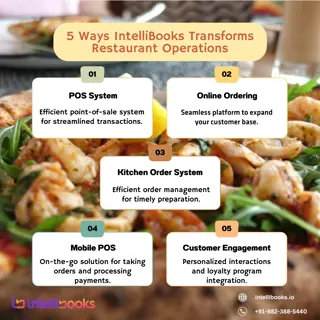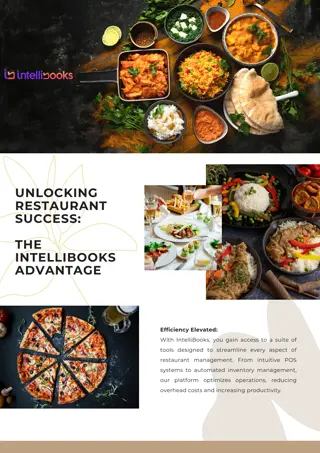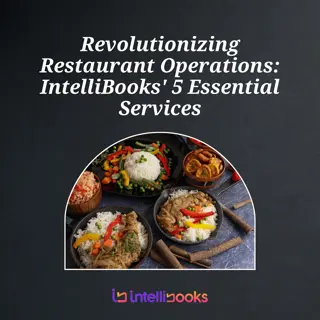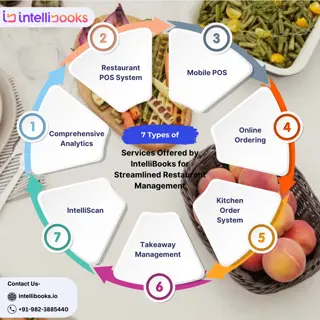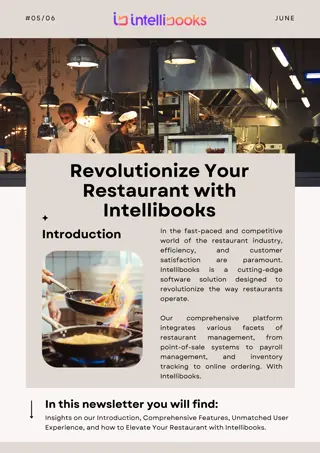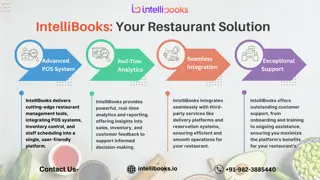The Dynamics of the Quick-Service Restaurant Sector in the US
The quick-service restaurant (QSR) sector in the US is dominated by fast-food chains, with McDonald's leading the burger category and Chick-fil-A soaring in the chicken segment. The rise of technology in drive-thru services is reshaping customer experiences, with AI poised to revolutionize order processes. Data shows the widespread popularity of QSRs, with millions of adults frequenting fast-food establishments weekly. The competitive landscape is fierce, as major players invest in innovation and enhancing customer satisfaction.
Download Presentation

Please find below an Image/Link to download the presentation.
The content on the website is provided AS IS for your information and personal use only. It may not be sold, licensed, or shared on other websites without obtaining consent from the author. Download presentation by click this link. If you encounter any issues during the download, it is possible that the publisher has removed the file from their server.
E N D
Presentation Transcript
Fast Food Is All-American as Apple Pie In its analysis, The NPD Group considers the overall quick-service restaurant (QSR) sector to include fast- casual restaurants, but which only have a 17% share, while traditional quick-service restaurants, or fast food, hold a 75% share. Data from The Media Audit s Aggregate Survey (September 2019) supports the vast popularity of QSRs, as 31.2%, or 49.0 million adults 18+ of a base population of more than 157 million, ate at a fast-food restaurant 3+ times during the last week. This would extrapolate to 84.55 million adults of the entire US adult population of approximately 271 million. Of the 13.5% of adults who ate at a fast-food restaurants 5+ times during the past week, the extrapolated total would be 36.59 million adults.
Burger Sector: Its Still McDonald s and Everyone Else It s clear from the table on page 1 of the Profiler that McDonald s dominates the burger category, with Wendy s, its closest rival, generating only 25% of McDonald s 2018 revenues; however, Burger King was a close third to Wendy s. McDonald s is investing in its future to remain the top dog in the burger category and among all QSRs with the acquisition of Dynamic Yield and its personalization technology that reportedly will significantly advance the drive-thru process. Wendy s recovered from a $500 million revenue loss and did so with new cheeseburgers and chicken sandwiches. Burger King didn t perform well during 2018, but it has initiated a more robust marketing strategy that includes promotions, especially its BK app.
Chicken Sector: Chick-fil-A Flying High Above the Competition Chick-fil-A is not just the #1 QSR in the chicken category by revenues, but also two Q3 2019 Business Industry surveys found 71% of consumers said it had the best service and 55% said it was the cleanest fast- food restaurant. Another 2019 consumer survey, of 7,600 by Market Force, showed Chick-fil-A with the largest Composite Loyalty Index, or 79%, although Raising Cane s was a close second at 78%. Chick-fil-A also scored the fewest problem situations, or just 3% of customers. Of the 8 categories in the survey, Chick-fil-A was first in staff friendliness, overall cleanliness, food quality, curb appeal, speed of service, value for money spent and healthy options. Raising Cane s was first in atmosphere, but Chick-fil-A was second.
The Challenge of Improving the Drive-Thru Process QSR drive-thru technologies have been advancing rapidly during the last decade, from LED to digital menuboards to tablets to mobile ordering. Artificial intelligence (AI) will be next, possibly eliminating drive- thru staff and predicting customers orders. The continuous introduction of new technologies may be why the average customer was in the drive-thru line (from order to window) 20 seconds longer during 2019 ( a total of 255 seconds) than 2018, according QSR s 2019 Drive-Thru Performance Study. Dunkin was first in speed-of-service from the June August 2019 survey, at 216.75 seconds, with Wendy s second, at 230.38 seconds. In the order-accuracy category, Chick-fil-A was first, at 94%, and was overall #1 in the customer-service category.
Breakfast and Lunch Customers Spending and Consumer Traits As the giant of the QSRs, McDonald s was first among breakfast and lunch loyalists behavior at competing QSR franchises in three critical spending categories: average quarterly spend, visits per quarter and percentage who shopped there. (See table in Profiler.) The Viant study also found breakfast and lunch loyalists are also Nordstrom shoppers, spending $300 more and $652 more quarterly, respectively, than the national average. The top TV programs among breakfast loyalists were NCAA Football, 25%; The Voice, 6%; and Dancing with the Stars, 5%. Lunch buyers were quite different: Fixer Upper, 25%; The Big Bang Theory, 15%; and Family Guy, 12%.
Dinner and Weekend Customers Spending and Consumer Traits Viant s study also included dinner and weekend sandwich shop loyalists. Dinner buyers share a number of affinities with lunch loyalists, as more are likely to drive a large vehicle, with 14% more likely to drive a Jeep Wrangler. The top TV programs among dinner loyalists were ESPN, 31%; House Hunters International, 16%; and Shark Tank, 9%. For weekend loyalists: NCAA Football, 30%; House Hunters, 20%; and Family Guy, 15%. When measuring sandwich shop dinner and weekend loyalists behavior at competing QSR franchises, Viant found their average quarterly spend was highest at Chick-fil-A, or $64.11 (dinner), and $70.05 (weekend).
Advertising Strategies Although challenging, the QSR model is so popular with consumers that there are opportunities for smaller chains and independents to increase their market shares, but they must do their best to match the menu and technological advances of the big chains. One of those opportunities is to add the next-generation of plant-based burgers (Nestl Incredible Burger, Lightlife Burger, The Vegetarian Burger and Tofurky DIY Burger) to their menus before the big chains, and promote them aggressively. Small chains and independents can also boost their market shares by squeezing all the efficiency they can from their drive-thru systems, since they are unlikely to be able compete with the major chains introduction of artificial intelligence and automation.
New Media Strategies To optimize the efficiency of their drive-thru systems, small chains and independents can conduct online surveys based on the contents of the table (Ease of Entering Drive-Thru) at the bottom of page 2 of the Profiler to obtain data to drive improvement. Although airing commercials during the top TV programs for breakfast, lunch, dinner and weekend sandwich shop loyalists would be cost-prohibitive for small QSR chains and independents, they could enter those conversations in social media to boost branding. Small chains and independents can also use social media, especially short videos, to reveal their level of cleanliness, staff friendliness, etc. to emphasize they are able to match the same qualities in the big chains. Ask customers to submit short videos in support.





